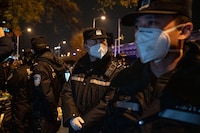
Dozens of people who took part in the protests have paid heavily for the dissent, subject to intense surveillance measures and aggressive interrogations in police custody, even as Beijing was shifting to unravel the policies.
Protesters in Beijing and Shanghai describe heightened digital surveillance, strip searches, threats against their families, and being forced into physical duress during interrogation.
The stories give fresh insight into the mechanisms put in place by Beijing to quash criticism of the government. They also highlight the perilous line regular people walk in expressing dissent in China — where opaque systems of policing and high-tech surveillance make protests rare and brief, while manipulation of the legal system and online debate often lead to ruinous repercussions.
“The virus is no longer the enemy, the health officials and quarantine are not the enemy … now only the people who protest are the enemy,” said Doa, a 28-year-old tech worker in Beijing who was detained after a protest. People who spoke to The Washington Post about interactions with police offered nicknames or spoke on the condition of anonymity because of the sensitivity of the matter.
Doa and a friend were at a protest near the Liangmahe bridge in eastern Beijing for around half an hour just after midnight Nov. 28 and kept a low profile, steering away from those filming on their cellphones and avoiding direct interactions with police. “I worked before in the social media industry. … I know how those things can be used by police,” she said. “They still found me. I’m still wondering how that is possible.”
Two days later, she awoke to a string of frantic calls and text messages from her mother, who said that police had called to tell her that her daughter had participated in “illegal riots” and would soon be detained. “I don’t know why they did it that way. I think it creates fear,” Doa said.
A few hours later, the police called her directly. She was summoned to a police station in northern Beijing, where her phone was confiscated and she underwent a series of interrogations over roughly nine hours.
“I had to undress to my underwear for a short period, it was very uncomfortable. They did not want to let me use the bathroom, for example.”
Doa said the police asked how she had heard about the protests, pushing for details of the accounts and names of people in her friend group.
“They wanted to know how I found out that the people were gathering. In the same way, I wanted to know how they knew about me, but I didn’t feel brave enough to ask. … I am not a political type person, I don’t write those things online,” she said. “All I can think of is that they knew my phone’s location.”
In the days and weeks following the unrest, authorities fanned out to find its instigators, setting into motion a police-led information-gathering network that has been fortified under President Xi Jinping with the aid of big data and high-tech policing.
There is no official figure on the number of people detained following the protests, and the Chinese government has not directly acknowledged arrests even occurred.
The Central Political and Legal Affairs Commission, which oversees domestic law enforcement, issued a non-specific warning that there would be a “crackdown” on any “infiltration and sabotage activities by hostile forces.” When a Foreign Ministry spokesman was asked about the arrest of protesters in November, he said only that reports did not reflect reality. But accounts from protesters and lawyers suggest there were at least dozens of similar incidents.
The Washington Post could not independently verify the accounts of the protesters. Two police stations in Beijing where incidents described by detainees occurred could not be reached for comment. Staff from a third police station in Shanghai declined to comment when reached by phone.
A web of silent surveillance
It’s not clear exactly how police traced protesters such as Doa in the vicinity of the November protests, but insights from lawyers, analysts, protesters and police purchasing documents offer some hints at the types of tools used.
Among protesters and human rights lawyers, one leading theory — considered likely but difficult to prove — is that the police used cell signal towers to pull all phone numbers from locations where crowds gathered and then deployed officers en masse to work through the list.
“[The police] seem to have used some modern technology, network technology, and they have collected a data pool of phone numbers of all the people involved in the incident,” said one lawyer with direct knowledge of protester cases. Like other lawyers The Post spoke to, they spoke on the condition of anonymity because of the matter’s sensitivity. “People have been called in for questioning one after another,” they said.
Since Xi came to power 10 years ago, China has undergone a revolution in the way it polices dissent, eroding anonymity online and in the real world by embracing widespread data collection and automated surveillance tools.
The government has also rapidly expanded the legal obligations of internet companies to share information with authorities, requiring them to not only provide information in criminal cases but also detailed data on broader threats to the Communist Party.
It includes a 2018 policy requiring internet companies to make regular detailed reports on trends that “mobilize” public sentiment or cause “major changes in public opinion.” Under the rule, companies must provide detailed information on individual users, including their real name, location and chat logs.
At the same time, China has blanketed its cities with hundreds of millions of surveillance cameras under an ambitious 2016 program called Sharp Eyes that set a goal of covering the entire population by 2020. It includes facial recognition cameras designed to automatically identify pedestrians and drivers and compare them against national ID registries and blacklists.
Police procurement documents issued in the years and months leading up to and immediately after November’s protests shed light on how these technologies were used during them.
They include advanced facial recognition cameras designed to raise alarms when “abnormal” crowd behavior is detected and track people across different locations over an extended period. They also include technology used to scrape and analyze cellphone data from hundreds of domestic and foreign apps.
In Beijing’s Chaoyang district, where Doa and other protesters gathered at the Liangmahe bridge, a 2018 police purchasing document describes “100% [surveillance] coverage,” using more than 19,200 advanced cameras. The documents, which have not been previously reported, are made public inside China but not easily accessible.
The purchase order notes facial recognition cameras in the system must be able to immediately log a pedestrian’s “name, former name, organization, gender, age, ethnicity, including whether they are Uyghur or not, and birth date,” and maintain the logs for months or longer. The cameras must also be able to carry out identification on people wearing masks or sunglasses.
A similar system was purchased in Shanghai’s Xuhui district, where protests erupted in late November, and has undergone continuous upgrades. Police submitted a purchase request in December to blanket a single street near the protest site with 620 surveillance cameras.
The Post reviewed dozens of police procurements for phone-scanning technology in the cities where major protests were held, including mobile terminals that can be used on the street. They list more than 1,000 apps that the equipment scrapes for data when a cellphone is scanned, including Facebook and Twitter, fitness and ride-sharing apps, and encrypted messaging services.
A ‘knock on the door’
While eavesdropping and data-collection devices were silently ransacking protesters, inside police stations, authorities were using more traditional methods of gleaning information.
The Post spoke with six people arrested who say they experienced stressful and physically demanding interrogations.
“We were only allowed to stand and could not talk to each other. They didn’t let us sleep, and if I did, they would knock on the door to wake me up,” said one Shanghai man, 25, who spoke on the condition of anonymity for fear of further repercussions.
He told The Post he was arrested during the protests near Shanghai’s Urumqi road, which in November became a mourning site for 10 people killed in an apartment fire in Xinjiang — a toll that some linked to covid controls. He said police sifted through his phone during questioning, asking about his friend groups.
The man said he saw others detained who were handcuffed and forced into a squatting position for around an hour after failing to comply. He said officers punished them in the station by making them do squat exercises and copy by hand pages of political documents from the 20th National Congress of the Chinese Communist Party.
“The purpose [of questioning] was to find out who planned it; they thought it was the separatists or foreign forces,” he said. The officers taunted men in the group with long hair, calling them gay, he added. “They would also call us traitors and running dogs and tell us to get the hell out of China.”
Days after the protests, Chen Wenqing, head of the Communist Party’s top law enforcement decision-making body, urged vigilance against “sabotage by hostile forces” and “criminal acts that disrupt social order.”
The accusations of foreign influence echo Beijing’s line on pro-democracy protests in Hong Kong, which in recent years has compelled a broad expansion in the surveillance of overseas social media services, which are banned in China but can be accessed through VPN technology.
The Post earlier reported that hundreds of police stations and government bureaus across China purchased big data surveillance tools to automatically identify individuals at home and abroad behind critical trends in public opinion on foreign social media apps.
A month before the protests began in Beijing, the city’s Ministry of Public Security issued a procurement for a 580,000-yuan ($84,000) data surveillance project combining human analysts and automated scraping tools to undertake 24-hour screening of domestic and overseas news and social media accounts discussing issues that could snowball into dissent in China.
“Especially news related to domestic people’s livelihood and hot social issues,” the document reads. It says the network should be capable of collecting, analyzing and reporting thousands of relevant pieces of information to police each day, and must have methods of recovering deleted social media posts. Services targeted include Twitter and Facebook.
Reports from lawyers and protesters also suggest Beijing police circumvented log-in protocols using domestic telecommunications firms to provide details of two-factor authentication messages sent to citizens’ phones. Under Chinese law, telecommunications providers are required to comply with such requests.
A 31-year-old man in Beijing told The Post he was interrogated and detained overnight Dec. 2 after reposting a video of protest scenes on Twitter and the domestic app WeChat, though he had not participated in person. “There was no sleep, no rest. … Up until the moment I was dismissed, they made me believe I was going to prison for a long time.”
He said that the evening after his detention he received a two-factor authentication message from Twitter that he hadn’t requested. “Even two weeks after it happened again … it feels like a scene in some horror movie where someone is always watching, but I don’t know for sure.”
One human rights lawyer working with protesters received notifications of two attempted log-ins on their Telegram messaging account on Dec 1. The effort failed, but whoever was trying to access the account — the lawyer suspects it was the police — was able to input a one-time log-in code correctly, according to screenshots of the incident shared with The Post.
Intense pressure on legal professionals who offer counsel to protesters leaves those facing prison sentences with little hope of a fair trial.
“It’s very sensitive — more sensitive than our previous cases related to human rights activists and political dissidents,” said another lawyer who had been offering services to detainees until warnings from authorities. “There is a nationwide attempt to prevent lawyers from even giving legal consultation to these protesters, not to mention personally representing them.”
If all else fails, blame foreign influence
The protesters have also now been increasingly vilified online. Censors appear to be allowing selective discussion of the demonstrations — so long as it is critical.
As coronavirus cases spike across China, nationalist commentators now regularly blame deaths and overcrowded hospitals on tangfei, or reclining bandits — a pun on official warnings not to lie down and let the virus run rampant — who they claim compelled the sudden dismantling of zero-covid restrictions before authorities were ready.
Groundless accusations of colluding with foreigners or causing the coronavirus outbreak stigmatize protesters, said Chih-Jou Jay Chen, professor of sociology at Academia Sinica in Taipei, Taiwan.
“The party has total control of the legal system to prevent protesters from getting a fair trial,” especially if they are labeled “hostile forces,” Chen said.
One widely shared post on the microblog site Weibo said the government was not at fault for a lack of preparation and urged people to focus their anger on those “who attacked and then scurried away,” asking, “Why shouldn’t they be reported to the authorities?”
Pei-Lin Wu in Taipei, Taiwan, and Theodora Yu in Hong Kong contributed to this report.








